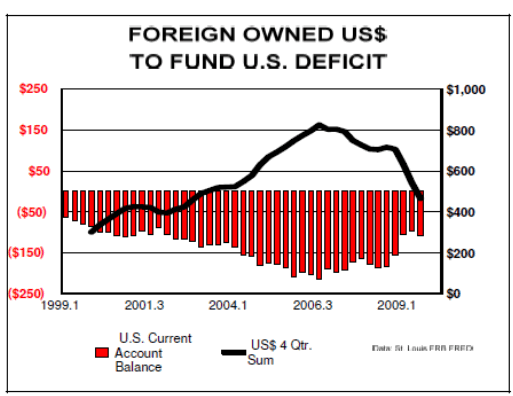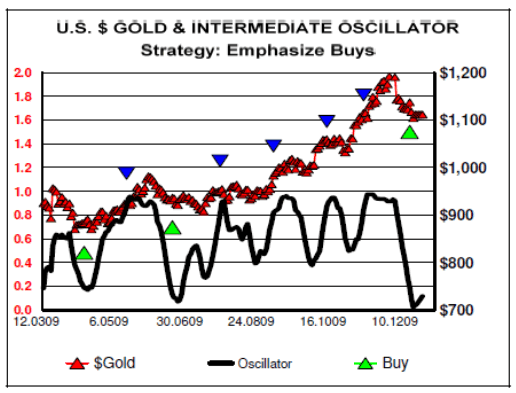Gold Forecast 2010
Commodities / Gold and Silver 2010 Dec 21, 2009 - 03:45 PM GMTBy: Ned_W_Schmidt
 With our last comments of the year 2009 we pose the all-important question. How did Gold Bugs do in 2009? Well, as the chart below shows, the Gold Bugs won again! In fact, $Gold has been victorious over the paper asset groupies on both the five year and ten-year measurements. For 15 years results are almost tied. Will take another year or so to best paper assets on a 20-year basis. Seems that Buy & Hold does work, if one buys and holds the right stuff! By the way, the S&P data is on a total return basis which includes the dividend.
With our last comments of the year 2009 we pose the all-important question. How did Gold Bugs do in 2009? Well, as the chart below shows, the Gold Bugs won again! In fact, $Gold has been victorious over the paper asset groupies on both the five year and ten-year measurements. For 15 years results are almost tied. Will take another year or so to best paper assets on a 20-year basis. Seems that Buy & Hold does work, if one buys and holds the right stuff! By the way, the S&P data is on a total return basis which includes the dividend.

2010 may be somewhat harder for all investors. In looking out to what may happen in the coming year the world must continue to look to China and India for economic growth. With the Obama Regime focused on raising taxes and destroying the U.S. health care system, little economic growth can be expected from the U.S. That said, a ball rolling downhill will bounce periodically into the air, but the trend is still downhill, and U.S. economic statistics will perform in similar fashion.
Three trends may influence the price path of $Gold in the coming year. First, investors of the world are going to own more Gold a year from now than they own now. Be they individuals or central banks, Gold has been discovered to be a better investment than paper assets. Those brainwashed by years of listening to the false dogma of Keynesianism simply take longer to be retrained.
Aside from the secular trend to greater Gold ownership are two possible trends that might influence $Gold. Either interest rates in the U.S. are going to rise or the Federal Reserve will be forced to monetize much of the massive amount of debt to be issued by the Obama Regime. And spending money is high on the agenda of the Obama Regime, as it needs to buy a vast number of votes before the November 2010 election. As we write, the Rasmussen Presidential Approval Index is at -17%. The tyranny of the party in control of the U.S. Congress has been recognized, and the error of two years ago is to be reversed.
The deficit of the U.S. government over the past year has been about $1.4 trillion. Already Congress is moving to spend more money on pork projects disguised as a jobs bill. Despite the recognition that Keynesianism has been a complete failure, Obama Regime and Congress will do all they can to buy votes. But, that raises the really big question: Who will buy that U.S. debt?
Zhu Min, deputy governor of the People’s Bank of China, seems able to look at the complexity of the world, and then distill it down to a concept so simple that even a Keynesian-trained economist might understand. His comments were reported by ShanghaiDaily.com on 18 December 2009,
“IT is getting harder for governments to buy United States Treasuries because the US’ shrinking current-account gap is reducing supply of dollars overseas, a Chinese central bank official said yesterday.”
“‘The United States cannot force foreign governments to increase their holdings of Treasuries,’ Zhu said, according to an audio recording of his remarks. ‘Double the holdings? It is definitely impossible.’” [Emphasis added.]

The problem that Governor Zhu has observed is shown in our first graph, above. The red bars, all of them in the negative, are the quarterly current account deficits of the U.S. That plot uses the left axis. Largest component of that deficit is the trade deficit. Those dollar outflows from the U.S. are dollar inflows to the receiving nation. Those dollars received in exchange for goods are the dollars with which foreign central banks purchase U.S. debt. Due to the vast nature of the Obama Recession, U.S. consumers have had to reduce their purchases of foreign goods, causing both the trade deficit and the current account deficit to become smaller.
In order to better visualize Zhu’s message, a four quarter sum is shown using the black line, and the right axis. As 2006 drew to a close, foreign nations were receiving dollars at about an $800 billion annual rate. That provided plenty of money with which to buy U.S. debt. More recently that sum is approaching $400 billion. In short, foreign nations have about four hundred billion less with which to buy U.S. debt. In the coming year, the Obama Regime will need to borrow almost two trillion dollars. Foreigner investors, at the same time, will have less funds available with which to buy that debt.
Essentially, four buyers exist for U.S. debt. They are:
- U.S. investors
- Foreign investors
- Foreign central banks
- Federal Reserve
We have just observed that foreign investors and foreign central banks will have fewer dollars with which to finance the Obama Deficit. They are unlikely to liquidate their other investments to buy what will likely be assets with a depreciating value. Remember, the Obama Deficit requires that foreigners buy more U.S. debt, not less.
U.S. investors may continue to buy, assuming they have the spare money with which to invest. With real U.S. unemployment at15-17%, most unable to tap any remaining equity in their homes, and burdened by higher taxes being imposed by the Obama Regime, they are an unlikely source to finance the Obama Deficit. In short, that leaves only one possibility left to finance the spendthrift ways of the U.S. government.Federal Reserve will have no choice but to monetize the Obama Deficit in the coming year. It will become essentially the buyer of last resort for U.S. debt in 2010.
By March the dismal tax revenue situation of the U.S. government will be readily apparent. Federal Reserve will be forced to begin monetizing U.S. debt. If they do not, U.S. interest rates will rise. Having just been approved by the U.S. Senate to continue as Chairman of the Federal Reserve, will Bernanke allow interest rates to rise in an election year? A reasonable formulated answer would be that Bernanke will not allow U.S. interest rates to rise. The Federal Reserve will enthusiastically monetize U.S. debt as its contribution to November elections.
Our final chart this week, below cause it did not fit above, is of the price of $Gold and our oscillator. That indicator recently gave the first buy signal of this correction on Gold in all currencies that we follow. That measure usually gives multiple buy signals as $Gold attempts to find the ultimate bottom in this correction. The first buy signal is usually well early in a correction. We normally advise investors to put some of their reserves into the Gold market on each as we do not know what will be the final bottom.
As much of the recent run up in $Gold was speculative fluff, multiple sell offs will likely be necessary to complete this correction. Perhaps as much as $100, or more, of the recent rally was not real, and should not have been expected to remain. That trading fluff may cause the first part of 2010 be somewhat more difficult than popular expectations. We note that this year will end without the U.S. dollar disappearing, or $Gold at $5,000.

This correction may go on as far as late February, or maybe even early March. By that time, necessity of the Federal Reserve injecting liquidity into the U.S. financial system should be readily apparent, as discussed above. The rally from the early 2010 low should be rewarding. In addition to the discussion above, other forces are at work such as the ongoing deficit and debt problems of Greece, Spain, Ireland, and the U.K. Greece may be a classic example of the butterfly in Africa flapping its wings that changes the price of Gold all around the world. While the latter part of 2010 is expected to be good for Gold, the on balance return for the year may be unexciting in the minds of many.
By Ned W Schmidt CFA, CEBS
Copyright © 2009 Ned W. Schmidt - All Rights Reserved
GOLD THOUGHTS come from Ned W. Schmidt,CFA,CEBS, publisher of The Value View Gold Report , monthly, and Trading Thoughts , weekly. To receive copies of recent reports, go to http://home.att.net/~nwschmidt/Order_Gold_GETVVGR.html
Ned W Schmidt Archive |
© 2005-2022 http://www.MarketOracle.co.uk - The Market Oracle is a FREE Daily Financial Markets Analysis & Forecasting online publication.



